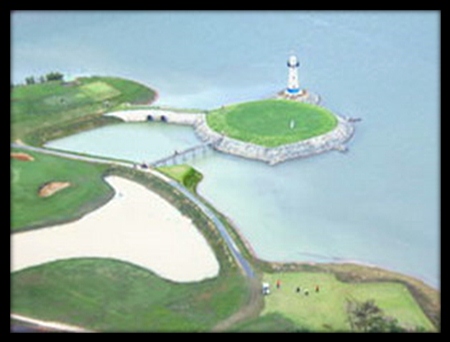Welcome to Golfnutter’s Blog – a weekly commentary highlighting contemporary golfing issues, in Pattaya and beyond. For more on matters golf, especially Pattaya golf, visit golfnutter.wordpress.com.
From time to time we will run a series on the Rules of Golf. This will vary from the obvious to the not so obvious, and feature golfing holes around Pattaya that regularly cause problems. If you have any specific golf holes you would like reviewed, send an email to [email protected] marked for the attention of Golfnutter.

First up we look at one of the iconic holes of the local golfing scene:
The par-3 third on Plutaluang’s North Course, known as “The Lighthouse Hole” is a classic. Imagine your ball pitching on to the green, taking a few bounces and then rolling agonisingly slowly off the apron, on to the embankment and into the sea. From where do you play your next shot? Where do you drop?
This hole is beautifully designed. Apart from it being an island, the putting surface is anything but flat and is subject to the elements. The length is usually around 115-125 yards from the white tees. It can’t make your round, but it can certainly break it.
The yellow stakes surrounding this hole tell us this is a Water Hazard. If the stakes (or lines) were red, it would be a Lateral Water Hazard. Our options, when taking relief, are outlined in Rule 26-1 Relief for ball in water hazard. The three options, all involving a one-shot penalty, are:
a. Drop a ball as nearly as possible to the spot from where you last played.
b. Drop behind the hazard keeping the last point of entry between you and the hole, with no limit as to how far back you drop.
c. If a lateral water hazard, drop outside the hazard within two club-lengths of and not nearer the hole than where the ball last crossed the margin of the hazard.
Note 1: IPGC and PSC do not recognise Drop Zones.
Note 2: under this rule, the player may lift and clean or substitute a ball.
Only option a. and b. apply to Water Hazards (yellow), whereas all three options apply to Lateral Water Hazards (red). The Lighthouse Hole does not permit option c.
Option a. is saying replay the shot from the teeing area, which is not a bad option. The alternative is option b., i.e. drop on a line keeping the point of entry between you and the hole.
Take a look at the picture. Imagine a line taken from the players on the tee direct to the top of the lighthouse and call that 12.00 o’clock.
If your ball landed on the green then rolled off, crossing the margin of the hazard anywhere between say 10.00 o’clock and 05.00, then your drop point will be miles away, on the other side of the bay.
Alternatively, if, after first hitting the green, your ball entered the water from that point between 08.00 o’clock and 09.00, then you could drop on or around the teeing area of the next hole. If your original ball hit the green before trickling off from the front, at 06.00 o’clock, then you would be entitled to drop in front of the tee, close to the water’s edge, thus taking maybe 20 yards off the shot.
Many tee-shots never make it to the green, landing directly on rocks or water. Simply take the point where the ball last crossed the hazard line, keeping that point between you and the hole, and drop anywhere on that line. In most cases replaying the shot from the tee will be the easier option.
What if the stakes were red? This would bring option c. into play. Providing your ball entered the hazard after first hitting the green, it would allow you to take your ball’s point of entry as your drop point. That is, you would be standing on the island while taking your drop. But they’re yellow, so you can’t.
Khao Kheow’s signature hole, B8, should be similarly regarded, as could Pattana A3, among others.
Water hazards may on occasions be unmarked. Local Rules of both IPGC and PSC state that unmarked water hazards should be treated as lateral (red) water hazards.
So there you have it. As a rule of thumb, red may mean you can drop at or around the point where the ball entered the hazard, but no nearer the hole. Yellow will almost always mean you have to drop on the other side of the hazard, or go back and replay the shot. If it’s yellow, it will invariably cost shot and distance. Red will cost a shot only.
Happy golfing!
Golfnutter




